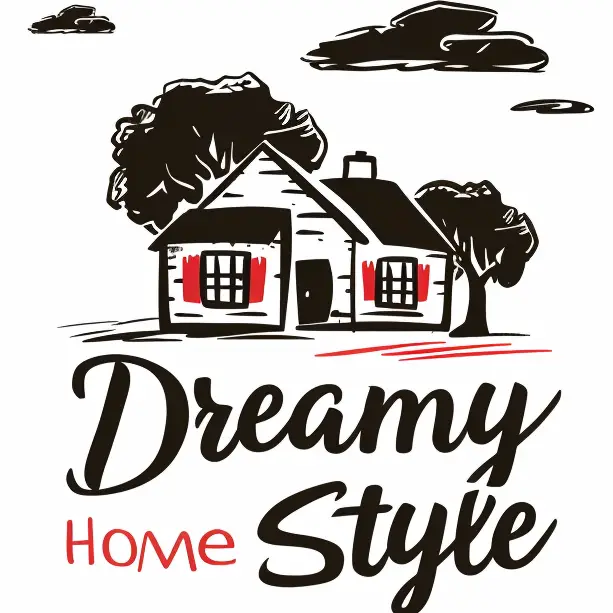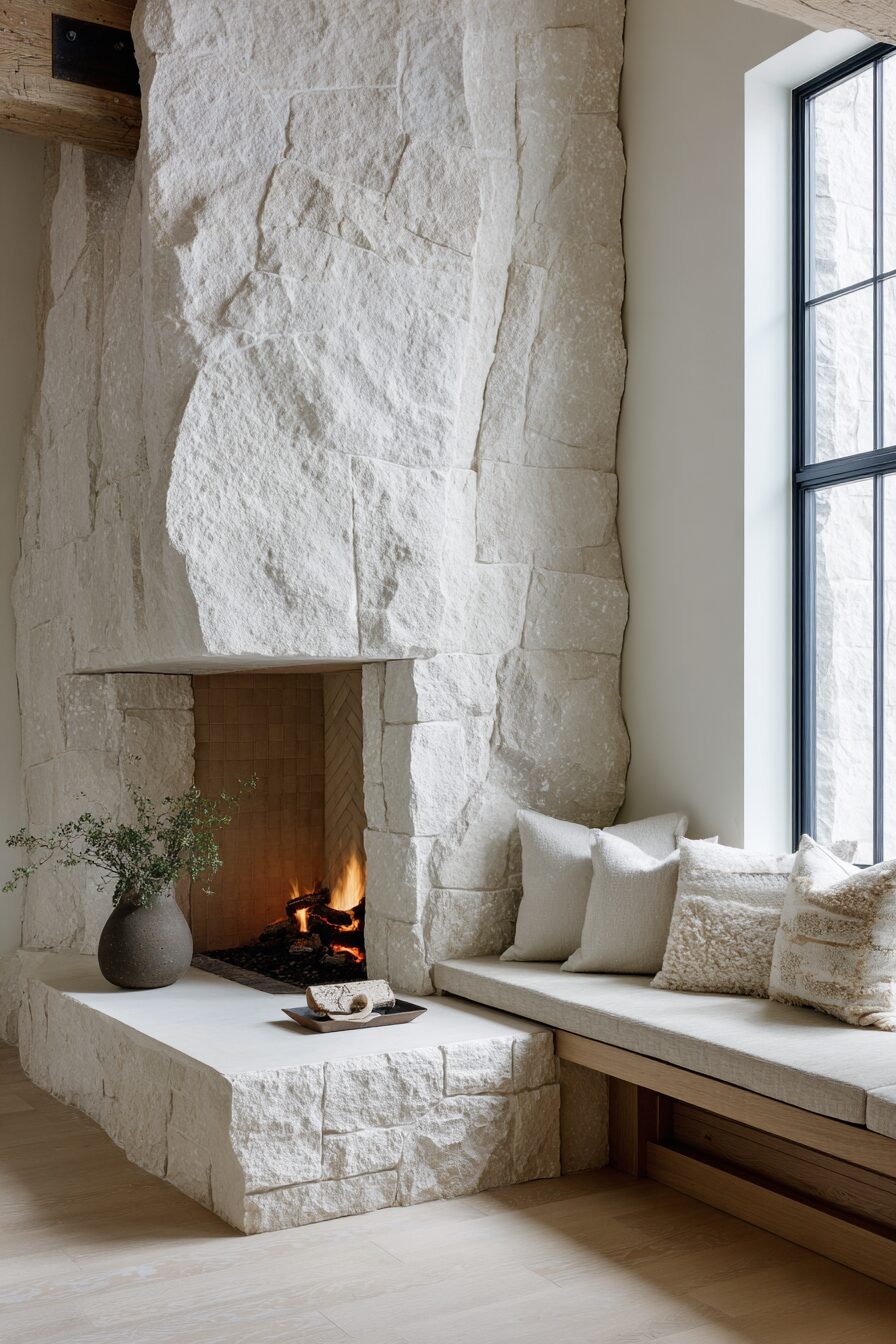Natural stone fireplaces have the power to completely transform any room from ordinary to absolutely extraordinary.
If you’re building new or renovating, these creative stone fireplace concepts will help you create a stunning focal point that combines timeless beauty with modern functionality.
Dramatic Floor-to-Ceiling Stacked Slate Wall
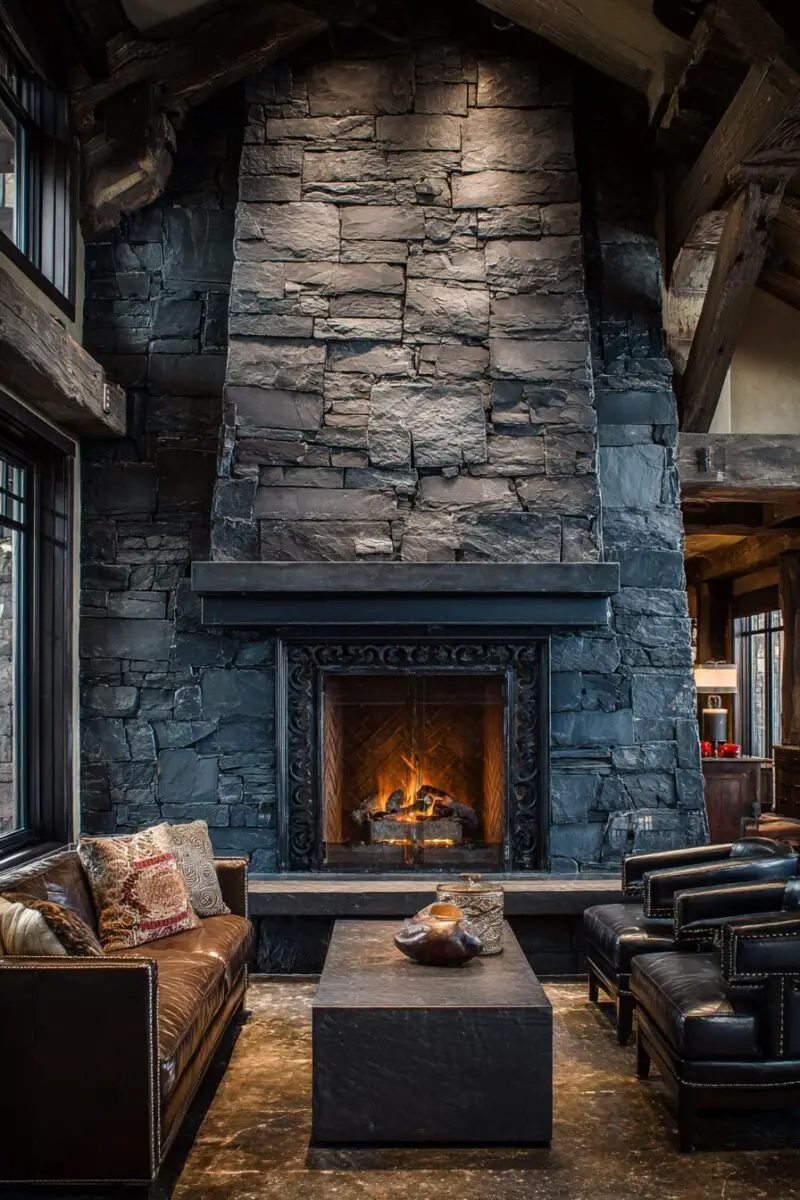
Imagine walking into a room where an entire wall appears to be carved from a mountainside.
A floor-to-ceiling stacked slate fireplace creates this breathtaking effect by extending natural stone from the hearth all the way up to your ceiling.
The key to this design lies in selecting slate pieces with varying thicknesses and natural color variations.
You’ll want to work with stones that range from charcoal gray to deep blue-black, creating a stunning gradient effect that changes with the lighting throughout the day.
The installation process involves creating a strong structural foundation that can support the weight of the stone wall.
Your contractor will need to ensure proper backing and anchoring systems are in place before beginning the stacking process.
Incorporate subtle LED strip lighting behind some of the protruding slate pieces to create dramatic shadows and highlight the natural texture of the stone.
This lighting technique adds depth and visual interest, especially during evening hours when the fireplace becomes the room’s primary light source.
The beauty of this design is how it works with both traditional and contemporary interior styles.
In a rustic setting, the slate wall complements exposed wooden beams and natural materials perfectly.
For modern homes, the clean lines and monochromatic color palette create a sophisticated backdrop for minimalist furniture and sleek accessories.
You can enhance this design by extending the slate treatment to include built-in shelving or entertainment center components.
These integrated features maintain the seamless appearance while providing functional storage and display space.
The maintenance requirements for a slate wall fireplace are surprisingly minimal.
Regular dusting and occasional sealing will keep the stone looking fresh and protect it from moisture and staining.
When selecting your slate, pay attention to the surface finish options available.
Honed slate provides a smooth, matte appearance that works well in formal settings.
Natural cleft slate maintains the rough, textured surface that gives the wall its authentic quarried appearance.
Split-face slate offers the most dramatic texture variation and creates the strongest visual impact.
TRENDING NOW
7+ Stylish Built-In Ideas Around Your FireplaceCurved River Rock Corner Design
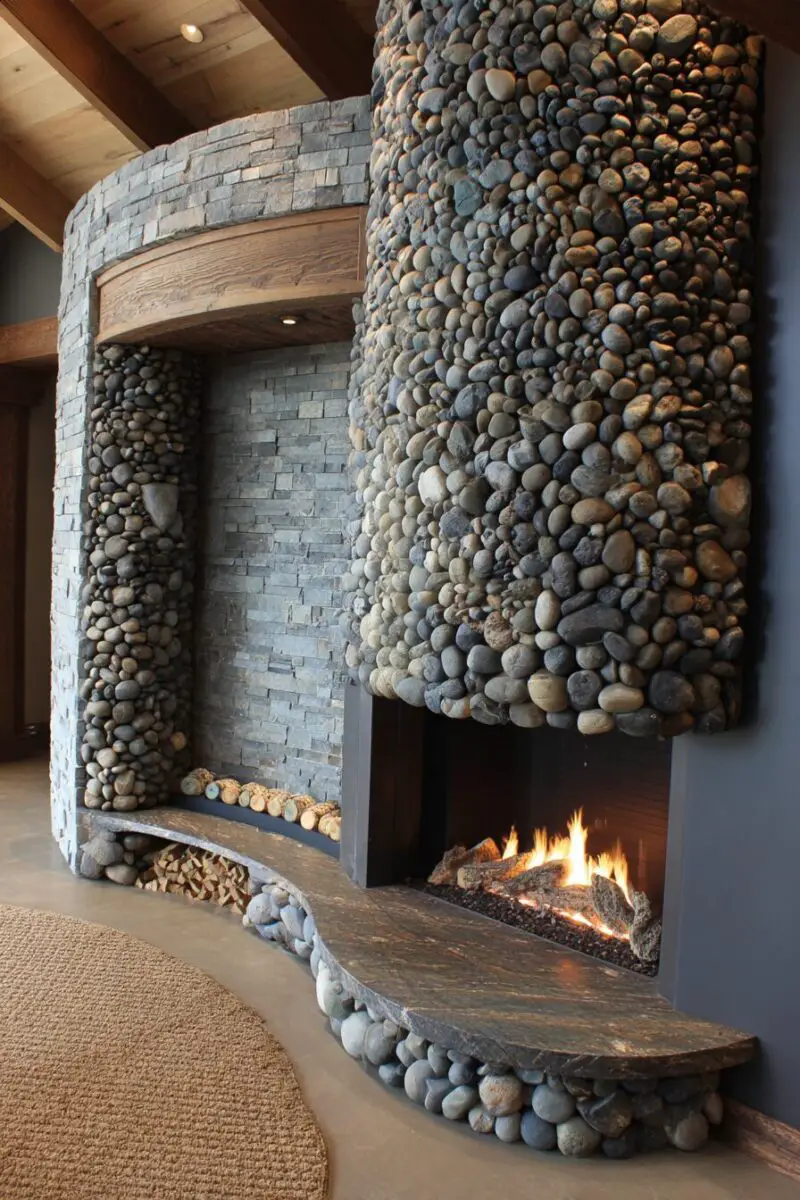
Picture a fireplace that looks like it was naturally formed by centuries of flowing water.
A curved river rock corner fireplace brings the organic beauty of a streambed directly into your living space.
This design works exceptionally well in rooms where you want to maximize floor space while creating a cozy gathering area.
The curved shape allows the fireplace to fit snugly into corner spaces that might otherwise go unused.
River rocks come in an incredible variety of sizes, colors, and textures, giving you endless possibilities for customization.
You can choose smooth, polished stones for a more refined appearance or select rougher, naturally weathered rocks for a more rustic feel.
The color palette can range from neutral grays and browns to more dramatic blacks, whites, and even subtle reds or blues.
The construction process begins with creating a curved metal framework that will support the river rock facade.
This framework must be engineered to handle both the weight of the stones and the heat generated by the fireplace.
Professional installation is crucial for this type of design, as the curved shape requires precise measurements and expert masonry skills.
Larger stones can serve as anchor points, while smaller rocks fill in the gaps and create smooth transitions.
The mortar joints should be kept narrow and consistent to maintain the natural appearance of the stone arrangement.
One of the most appealing aspects of this design is how it creates a sense of movement and flow within the room.
The curved lines soften the angular architecture typically found in modern homes.
This organic shape also helps to create better traffic flow around the fireplace area.
You can enhance the river rock design by adding complementary water features or incorporating live plants around the base.
Small ferns or mosses can be planted in specially designed pockets within the stone work.
This living element reinforces the natural streambed aesthetic and adds vibrant green accents to the neutral stone tones.
Lighting plays a crucial role in showcasing the beauty of river rock textures.
Consider installing small spotlights that graze across the surface of the stones, highlighting their unique shapes and creating interesting shadow patterns.
Design Your Dream Room in Minutes!
🏡 Start Creating FREE →Rough-Cut Limestone with Integrated Bench Seating
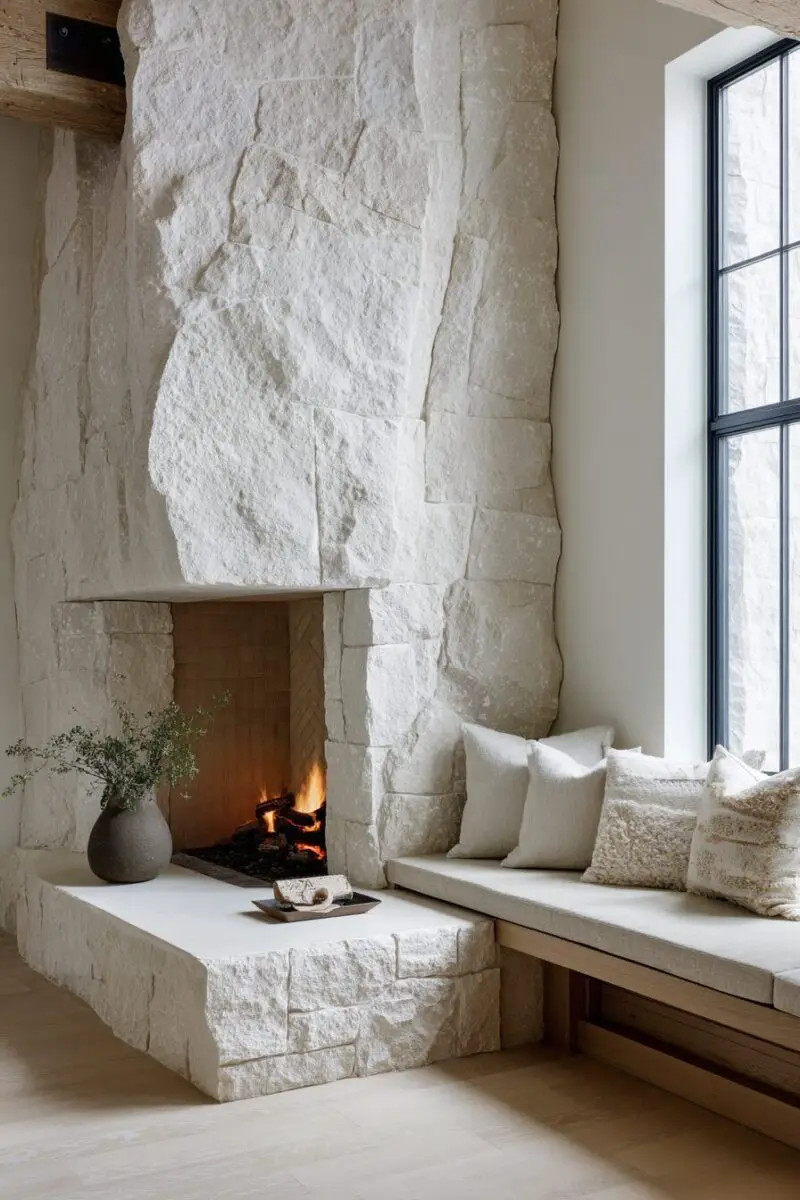
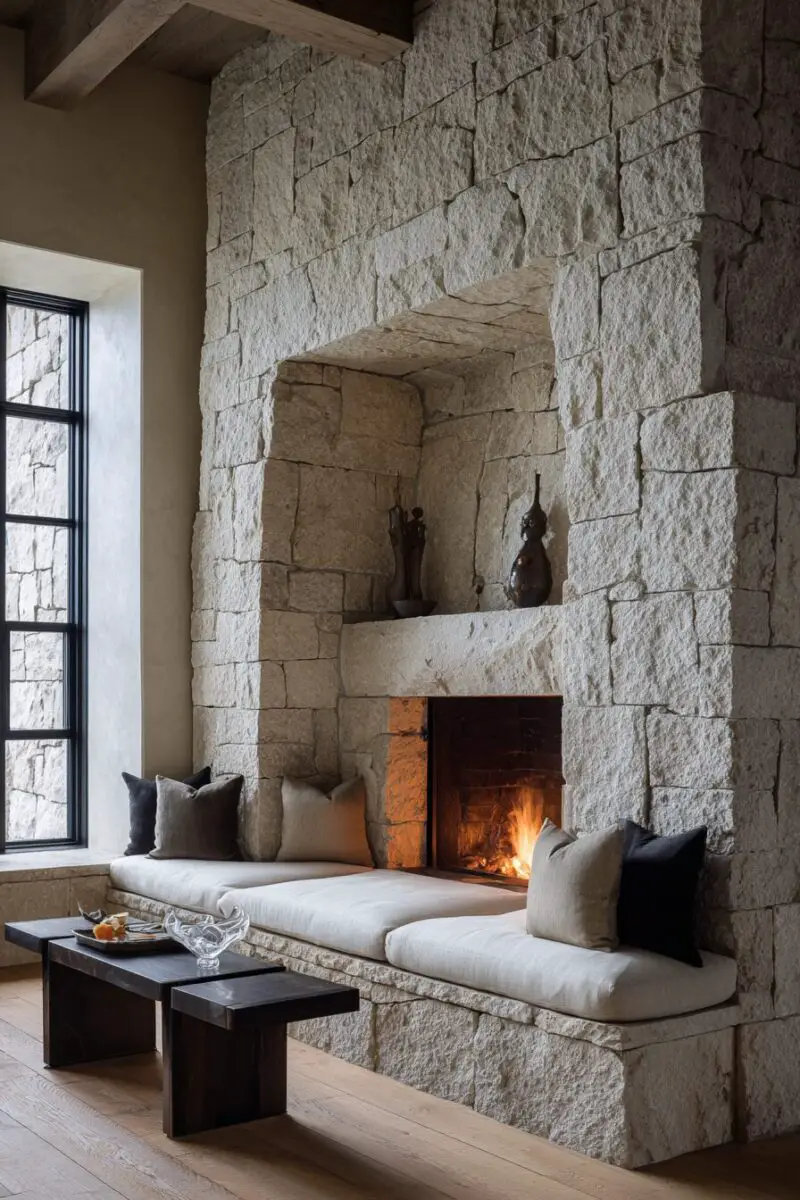
Envision a fireplace that doubles as the perfect spot for intimate conversations and cozy reading sessions.
A rough-cut limestone fireplace with integrated bench seating transforms your hearth into a multi-functional gathering space that maximizes both comfort and style.
This design concept works particularly well in larger rooms where you have the space to extend the stone work beyond the traditional fireplace footprint.
The rough-cut limestone provides a rustic, old-world charm that feels both timeless and substantial.
Unlike smooth, polished stone surfaces, rough-cut limestone retains the natural texture and irregularities that were created during the quarrying process.
These imperfections are actually the stone’s greatest assets, as they create visual interest and authentic character that can’t be replicated with manufactured materials.
The integrated bench seating should be designed with comfort in mind, incorporating proper height and depth measurements for extended sitting.
You’ll want the bench to be approximately 18 inches high and 16-20 inches deep to provide comfortable seating for adults.
The stone bench can be topped with custom cushions that complement your room’s color scheme and provide additional comfort.
Use weather-resistant fabrics if the fireplace is located in a three-season room or outdoor living space.
The limestone’s natural thermal properties make it an excellent choice for this type of integrated seating design.
The stone naturally absorbs and radiates heat from the fireplace, creating a warm and inviting seating area during cooler months.
During summer months, the limestone stays cool to the touch, providing a refreshing place to sit and relax.
You can customize the limestone finish to match your desired aesthetic preferences.
A natural cleft finish maintains the rough, quarried appearance and provides maximum texture variation.
Sandblasted limestone creates a more uniform surface while still retaining some natural texture.
Aged limestone finishes can simulate decades of natural weathering for an authentic vintage appearance.
The color variations in limestone range from warm creams and beiges to cooler grays and blues.
Some limestone varieties feature beautiful fossil inclusions that add unique visual elements to your fireplace design.
Storage opportunities can be incorporated into the bench design through hidden compartments or open cubbies.
These spaces are perfect for storing firewood, blankets, or seasonal decorations.
The integration should be seamless, maintaining the clean lines of the overall design while providing practical functionality.
Fieldstone and Reclaimed Wood Fusion
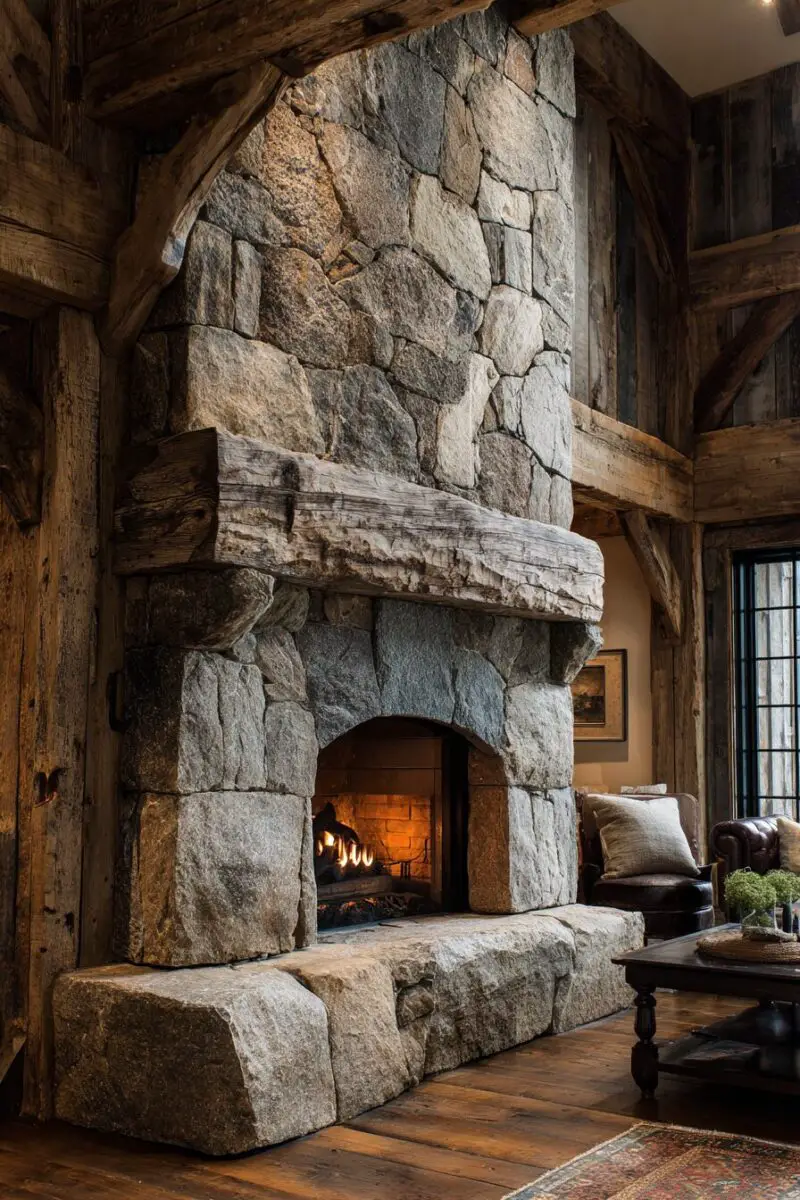
Imagine combining two of nature’s most beautiful materials to create a fireplace that tells a story of craftsmanship and environmental consciousness.
A fieldstone and reclaimed wood fireplace fusion brings together the rugged beauty of hand-gathered stones with the warm character of weathered timber.
This design approach creates a perfect balance between the cool, permanent nature of stone and the warm, organic qualities of aged wood.
Fieldstone, by definition, consists of stones that have been naturally weathered and shaped by centuries of exposure to the elements.
These stones are typically gathered from fields, stream beds, and other natural locations where they have developed their characteristic rounded edges and smooth surfaces.
The irregular shapes and varying sizes of fieldstone create a puzzle-like pattern that requires skilled craftsmanship to assemble properly.
Each stone must be carefully selected and positioned to create both structural integrity and visual harmony.
Reclaimed wood adds warmth and character that perfectly complements the earthy tones of the fieldstone.
The best reclaimed wood for fireplace applications comes from old barns, factories, and historic buildings that are being demolished or renovated.
This wood has developed a beautiful patina and character through decades of exposure to natural elements and human use.
The nail holes, saw marks, and other imperfections tell the story of the wood’s previous life and add authentic character to your fireplace design.
The combination of materials should be planned carefully to ensure proper proportions and visual balance.
You might use reclaimed wood as a mantel, extending horizontally across the top of the fieldstone fireplace.
Alternatively, vertical wood elements can be incorporated as side panels or accent pieces that frame the stone work.
The wood can also be used to create built-in shelving or storage areas that integrate seamlessly with the overall design.
Safety considerations are paramount when combining wood and stone in fireplace applications.
All wood elements must be properly treated with fire-retardant materials and positioned at safe distances from the firebox opening.
Your local building codes will specify minimum clearances and safety requirements for combustible materials near fireplaces.
Professional installation is strongly recommended to ensure compliance with all safety regulations.
The maintenance requirements for this type of fireplace design are relatively straightforward.
The fieldstone requires occasional cleaning and resealing to protect against moisture and staining.
The reclaimed wood should be treated with appropriate sealers or stains to maintain its appearance and protect against insect damage or moisture penetration.
Floating Hearth with Natural Stone Base
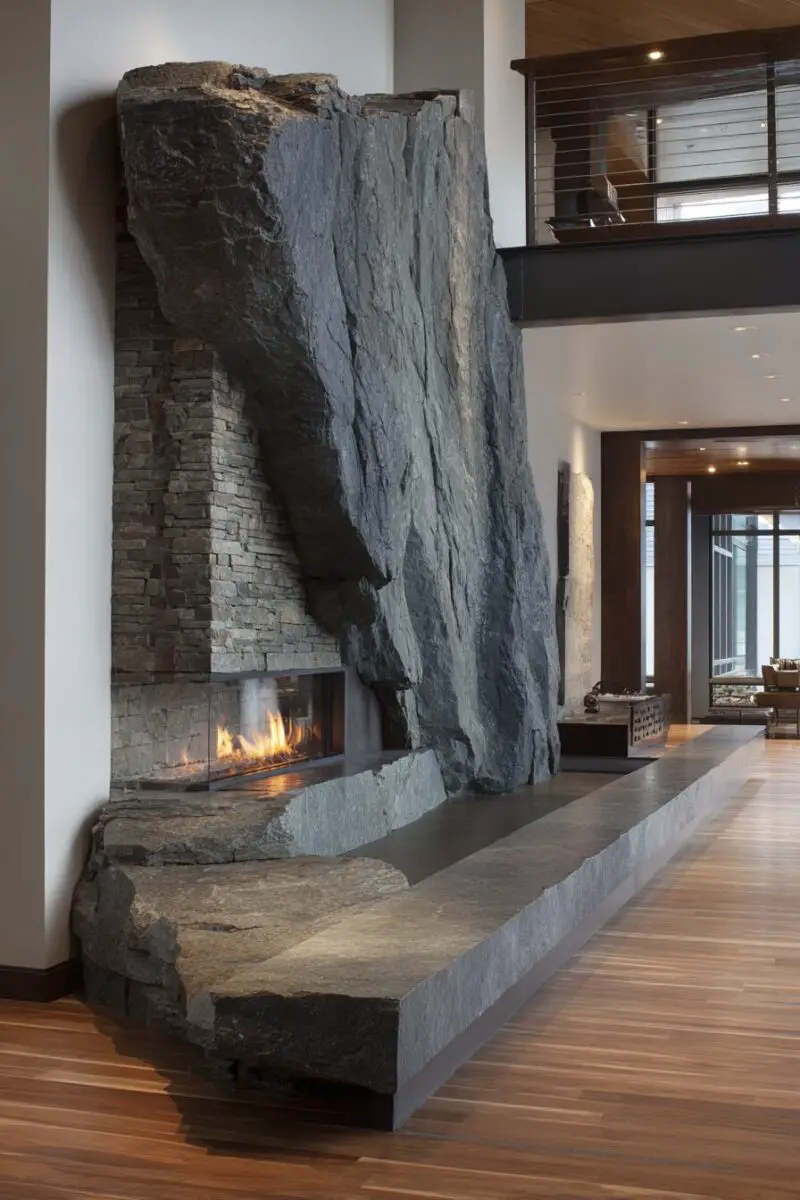
Picture a fireplace that appears to defy gravity, with a sleek hearth that seems to hover effortlessly above a stunning natural stone foundation.
A floating hearth design creates a modern, minimalist aesthetic while maintaining the timeless appeal of natural stone materials.
This contemporary approach to fireplace design maximizes floor space and creates clean, uncluttered lines that work beautifully in modern and transitional interiors.
The visual impact of a floating hearth comes from the apparent absence of visible support structures.
In reality, the hearth is supported by a carefully engineered steel framework that is hidden within the stone base and wall structure.
This hidden support system must be designed to handle not only the weight of the hearth itself but also any additional loads from people sitting on the hearth or objects placed on its surface.
Professional engineering is essential to ensure the structural integrity and safety of this type of design.
The natural stone base serves as both a visual anchor and a practical foundation for the floating hearth system.
You can choose from a wide variety of stone types, each offering different colors, textures, and visual characteristics.
Granite provides exceptional durability and comes in a stunning array of colors and patterns.
Sandstone offers warm, earthy tones and interesting texture variations that work well in both rustic and contemporary settings.
Marble creates a luxurious, elegant appearance with its distinctive veining and smooth surface finish.
The height and depth of the floating hearth should be carefully planned to ensure both safety and functionality.
Most floating hearths are positioned 12-18 inches above the floor, providing clearance for cleaning underneath while maintaining a comfortable height for use as occasional seating.
The depth typically ranges from 16-24 inches, depending on the room size and intended use of the hearth surface.
Lighting design plays a crucial role in emphasizing the floating effect and highlighting the beauty of the natural stone base.
LED strip lighting can be installed underneath the hearth to create a dramatic glow that enhances the floating illusion.
Additional accent lighting can be positioned to graze across the surface of the stone base, highlighting its texture and color variations.
These lighting elements should be dimmable to allow for different moods and occasions.
The space beneath the floating hearth offers unique opportunities for both storage and display.
Custom-designed storage compartments can be built into the stone base to hold firewood, fireplace tools, or other accessories.
Open display areas can showcase decorative objects, books, or seasonal decorations.
The clean lines of the floating design create a perfect backdrop for carefully curated decorative elements.
Multi-Level Stone Waterfall Feature
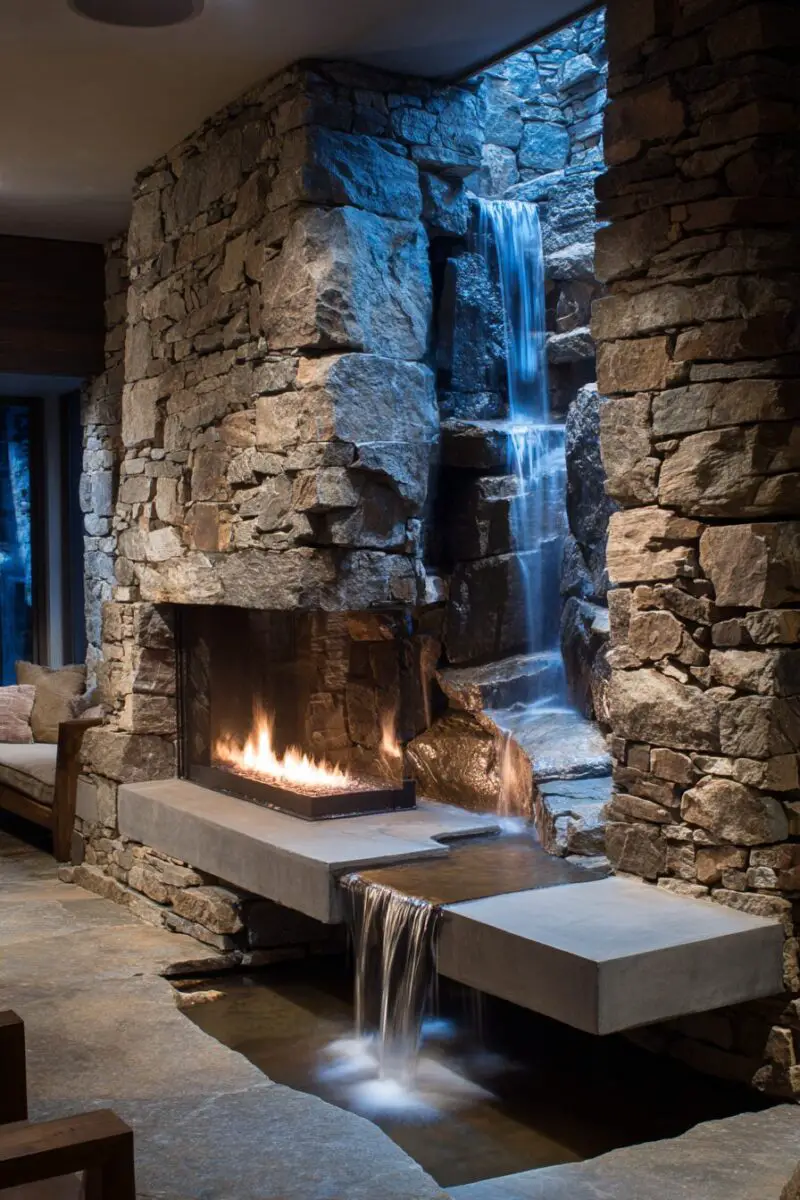
Envision the soothing sounds of cascading water combined with the warm crackle of a fireplace flame.
A multi-level stone waterfall fireplace feature creates a unique sensory experience that engages both sight and sound while serving as the ultimate relaxation focal point.
This innovative design concept integrates water elements directly into the fireplace structure, creating a harmonious blend of fire and water that represents the perfect balance of opposing natural elements.
The multi-level design allows water to flow from one stone level to another, creating a series of small waterfalls that produce gentle, relaxing sounds.
The engineering behind this type of feature requires careful planning to ensure proper water circulation, drainage, and protection of electrical components.
A closed-loop water system uses a hidden pump to circulate water from a reservoir at the base of the feature back up to the top level where it begins its journey down the stone cascade.
The pump must be sized appropriately to provide adequate water flow while maintaining energy efficiency.
Stone selection is critical for this type of water feature integration.
The stones must be non-porous enough to direct water flow properly while maintaining their structural integrity when exposed to constant moisture.
Granite and slate are excellent choices due to their low porosity and natural resistance to water damage.
The stones should be cut and shaped to create gentle channels that guide the water flow and prevent splashing or unwanted runoff.
Each level of the waterfall can incorporate different stone types or finishes to create visual interest and enhance the water flow patterns.
Safety considerations are paramount when combining water and fire elements in close proximity.
All electrical components, including the water pump, lighting systems, and fireplace controls, must be properly protected with ground fault circuit interrupters (GFCI).
The water reservoir and circulation system should be designed with overflow protection to prevent water damage to surrounding areas.
Regular maintenance includes cleaning the water reservoir, checking pump operation, and treating the water to prevent algae growth or mineral buildup.
The lighting design for a stone waterfall fireplace should emphasize both the flowing water and the natural beauty of the stone materials.
Submersible LED lights can be placed within the water reservoir to create a magical underwater glow effect.
Additional accent lighting can be positioned to highlight the texture and color variations in the stone work.
The combination of firelight, water movement, and strategic lighting creates a mesmerizing display that changes throughout the day and evening hours.
You can customize the water flow rate and patterns to create different moods and sound levels.
A gentle trickle provides subtle background sounds perfect for quiet conversation or reading.
A more robust flow creates a more dramatic visual and auditory impact that can serve as a natural white noise generator.
Stone Archway with Hidden Storage Solutions
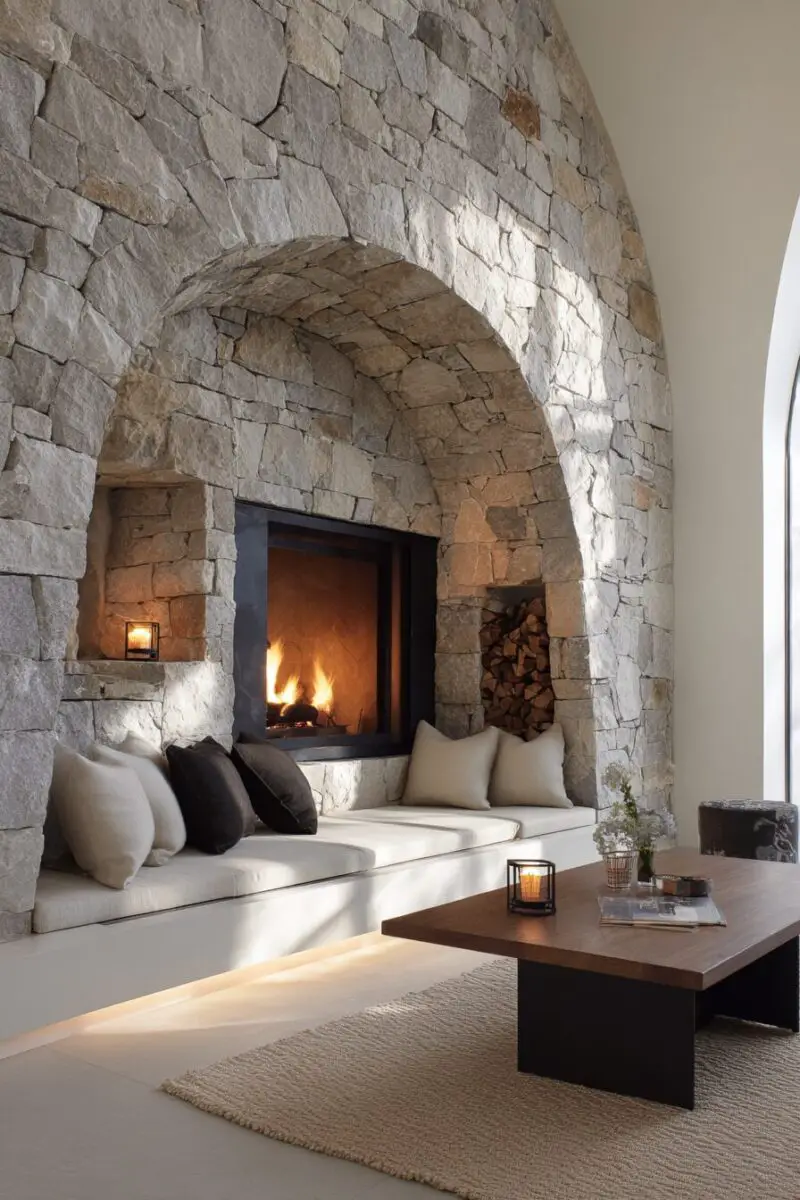
Imagine a fireplace that combines the grandeur of ancient architecture with clever modern storage solutions.
A stone archway fireplace with hidden storage transforms your hearth into a functional masterpiece that maximizes both beauty and practicality.
This design draws inspiration from classical Roman and medieval architecture while incorporating contemporary storage innovations that keep your living space organized and clutter-free.
The archway design creates a natural frame for your fireplace opening while providing structural opportunities for integrated storage compartments.
The arch itself can be constructed using traditional masonry techniques with carefully cut stone voussoirs that distribute weight evenly across the span.
Modern engineering allows for wider arch spans than were possible with historical construction methods, giving you more flexibility in fireplace sizing and room layout.
The keystone at the top of the arch can serve as both a structural element and a decorative focal point that ties the entire design together.
Hidden storage compartments can be seamlessly integrated into the stone work surrounding the archway.
Side panels flanking the fireplace opening can conceal storage areas for firewood, fireplace tools, blankets, or entertainment equipment.
These storage areas should be designed with proper ventilation and moisture protection to ensure the longevity of stored items.
Access panels can be disguised as decorative stone elements that blend invisibly with the overall design when closed.
The storage solutions should be planned during the initial design phase to ensure proper integration with the structural elements.
Custom millwork and cabinetry can be built into the stone surround to provide organized storage for different types of items.
Adjustable shelving systems allow for flexibility as your storage needs change over time.
Soft-close hinges and high-quality hardware ensure that access panels operate smoothly and quietly for years to come.
Stone selection for an archway design should consider both structural requirements and aesthetic preferences.
Limestone and sandstone are excellent choices for arch construction due to their workability and structural properties.
These stones can be precisely cut and shaped to create smooth, consistent arch curves.
The natural color variations in these stones add visual interest while maintaining the cohesive appearance necessary for successful arch construction.
Temperature control considerations are important when designing hidden storage areas near a fireplace.
Insulation and ventilation systems may be necessary to protect stored items from excessive heat.
Electronic items and sensitive materials require special protection from both heat and humidity fluctuations.
Built-in fans or passive ventilation systems can help maintain appropriate storage conditions.
The archway design can be enhanced with decorative elements that reflect your personal style preferences.
Carved stone details, such as floral motifs or geometric patterns, can be incorporated into the arch structure.
Contrasting stone colors or materials can be used to highlight the arch outline and create visual drama.
Metal accents, such as wrought iron details or copper elements, can complement the stone work and add textural variety.
Seamless Indoor-Outdoor Stone Continuation
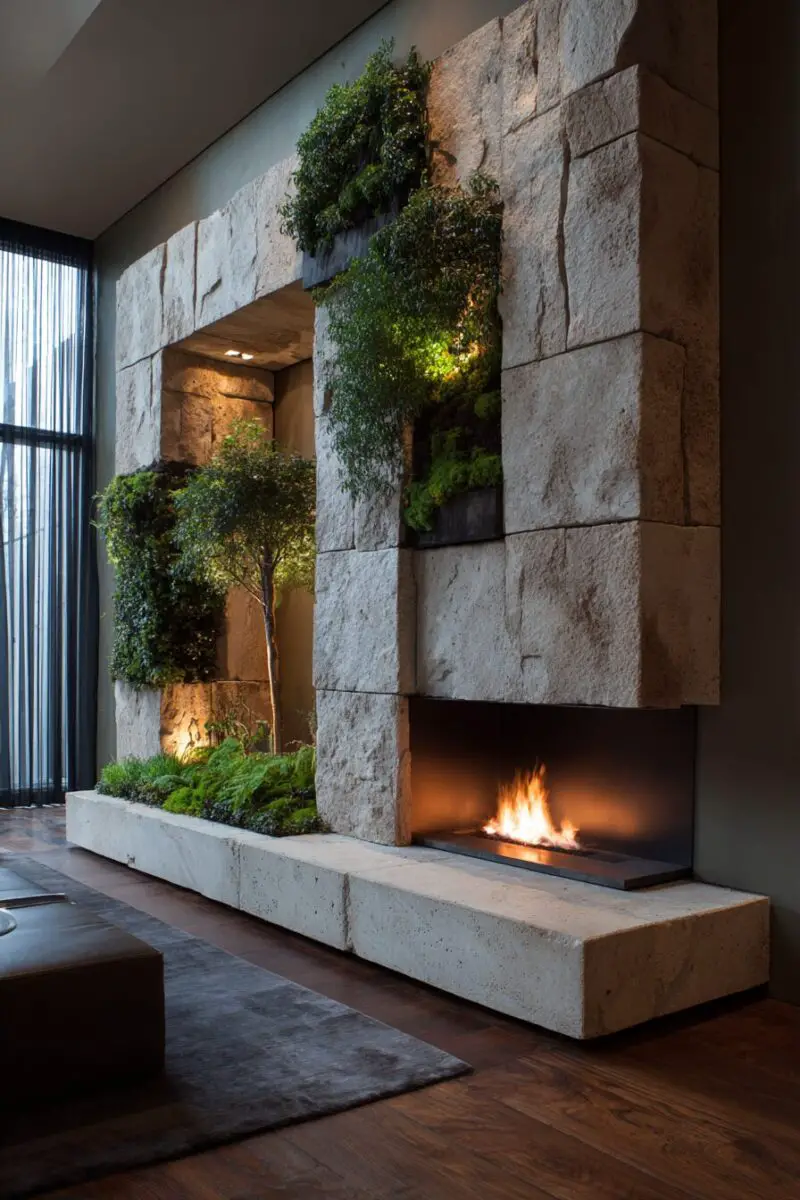
Picture a fireplace design that erases the boundaries between your interior and exterior living spaces.
A seamless indoor-outdoor stone continuation creates a unified design that flows effortlessly from your family room through glass doors to your patio or deck area.
This innovative approach to fireplace design maximizes your living space while creating a cohesive aesthetic that works year-round.
The key to success with this design concept lies in selecting stone materials that perform well in both interior and exterior applications.
The stone must be able to withstand freeze-thaw cycles, moisture exposure, and UV radiation while maintaining its beauty and structural integrity.
Granite, slate, and certain types of limestone are excellent choices for this type of application due to their natural durability and weather resistance.
The color and texture should remain consistent across both indoor and outdoor installations to maintain the seamless visual connection.
Engineering considerations for indoor-outdoor fireplace continuations require careful attention to building codes and safety requirements.
Separate fireboxes may be required for indoor and outdoor sections, each with appropriate ventilation and safety systems.
The transition area between indoor and outdoor spaces must be properly sealed and insulated to maintain energy efficiency.
Professional installation is essential to ensure compliance with local building codes and safety regulations.
The design should incorporate large glass doors or retractable wall systems that can open completely to merge the indoor and outdoor spaces.
When these barriers are removed, the continuous stone work creates the illusion of a single, expanded living area.
The fireplace becomes a central focal point that can be enjoyed from both inside and outside simultaneously.
This flexibility allows you to adapt your living space to different seasons and weather conditions.
Furniture placement should be planned to take advantage of the expanded space when the indoor-outdoor barriers are opened.
Modular furniture systems work particularly well for this type of flexible living arrangement.
Weather-resistant furniture for the outdoor section should complement your indoor pieces to maintain design continuity.
Built-in seating can be incorporated into the stone work to provide permanent seating options that work in all weather conditions.
Climate control considerations become more complex with indoor-outdoor fireplace designs.
The indoor fireplace should be equipped with efficient heat distribution systems that can warm the interior space effectively.
The outdoor fireplace may require wind guards or heat reflectors to maximize warmth and comfort in outdoor seating areas.
Automated damper systems can help control heat flow and prevent energy loss when the spaces are separated.
Maintenance requirements for continuous stone installations require attention to both indoor and outdoor needs.
Exterior stone surfaces may require more frequent cleaning and sealing due to weather exposure.
Indoor surfaces need protection from humidity and temperature fluctuations.
A comprehensive maintenance schedule should address both environments to ensure long-term performance and appearance.
Natural Stone with Integrated Living Plant Features
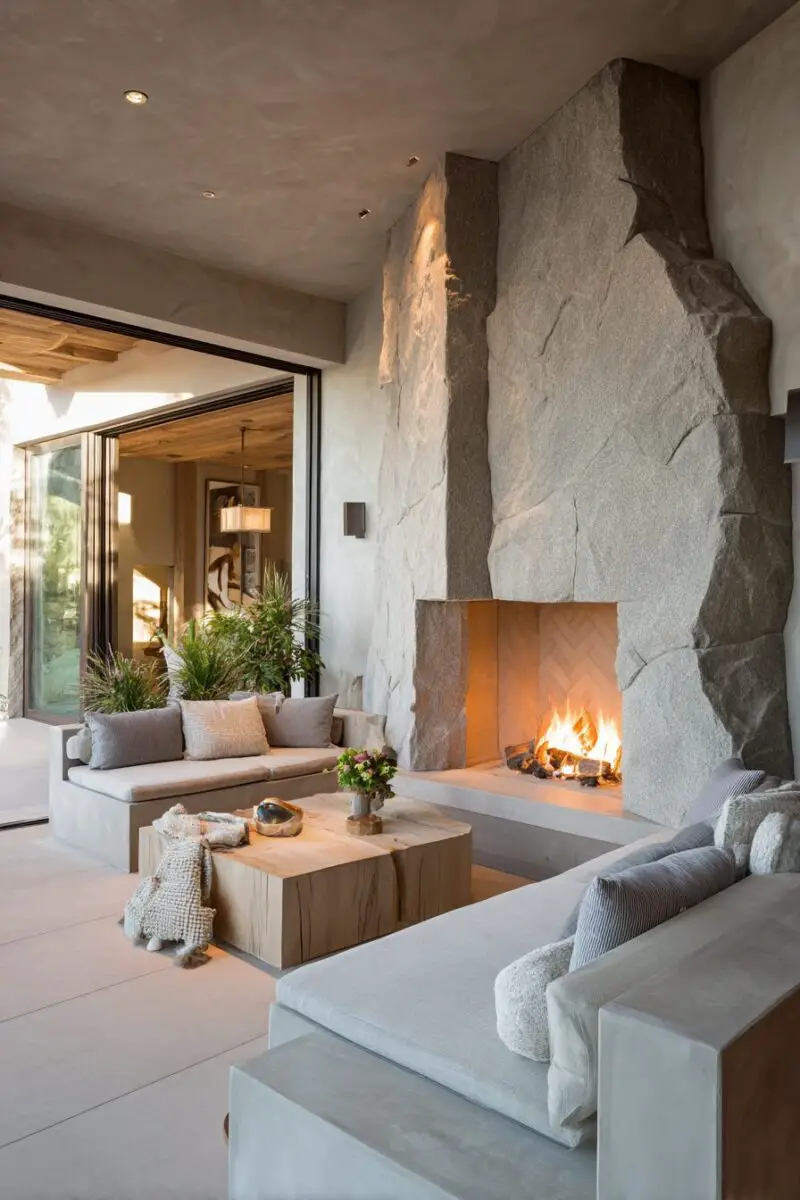
Envision a fireplace that brings the living beauty of nature directly into your home through thoughtfully integrated plant displays.
A natural stone fireplace with integrated living plant features creates a stunning biophilic design that combines the permanent beauty of stone with the dynamic, ever-changing appeal of living plants.
This innovative approach transforms your fireplace from a simple heating element into a living artwork that changes with the seasons and grows more beautiful over time.
The integration of plants into stone fireplace designs requires careful planning to ensure both plant health and fire safety.
Plant placement must be far enough from heat sources to prevent damage while close enough to create visual cohesion with the stone work.
Built-in planters can be incorporated into the stone surround at appropriate distances from the firebox opening.
These planters should include proper drainage systems and access for watering and maintenance.
The selection of appropriate plant species is crucial for success with this type of integrated design.
Low-maintenance plants that thrive in indoor conditions work best for year-round installations.
Succulents, ferns, and air plants are excellent choices that require minimal care while providing maximum visual impact.
Seasonal plant rotations allow you to change the color palette and texture combinations throughout the year.
Spring bulbs, summer flowering plants, and autumn foliage can create an ever-changing display that keeps your fireplace area fresh and interesting.
Stone selection should complement the natural colors and textures of your chosen plant materials.
Earth-tone stones, such as sandstone and limestone, provide neutral backgrounds that allow plant colors to shine.
Darker stones, like slate or granite, create dramatic contrast that makes green foliage appear more vibrant.
The texture of the stone should be considered in relation to plant forms and foliage patterns.
Smooth stone surfaces work well with spiky or architectural plants, while rough stone textures complement soft, flowing plant forms.
Lighting design becomes even more important when plants are integrated into fireplace designs.
Plants require appropriate light levels for healthy growth, which may necessitate supplemental lighting systems.
LED grow lights can be discretely integrated into the stone work to provide necessary plant lighting without compromising the overall aesthetic.
These lighting systems should be controllable separately from decorative lighting to allow for proper plant care scheduling.
The fireplace lighting should highlight both the stone materials and the plant displays for maximum visual impact.
Irrigation systems can be built into the stone work to simplify plant maintenance and ensure consistent watering.
Drip irrigation lines can be hidden within the stone joints and connected to automatic timers for hassle-free plant care.
Drainage systems must be carefully designed to prevent water damage to surrounding areas.
Waterproof membranes and proper slope design ensure that excess water is directed away from structural elements.
TRENDING NOW
9+ Fireplace Hearth and Mantel Decorating IdeasGeometric Stone Pattern Modern Minimalist Design
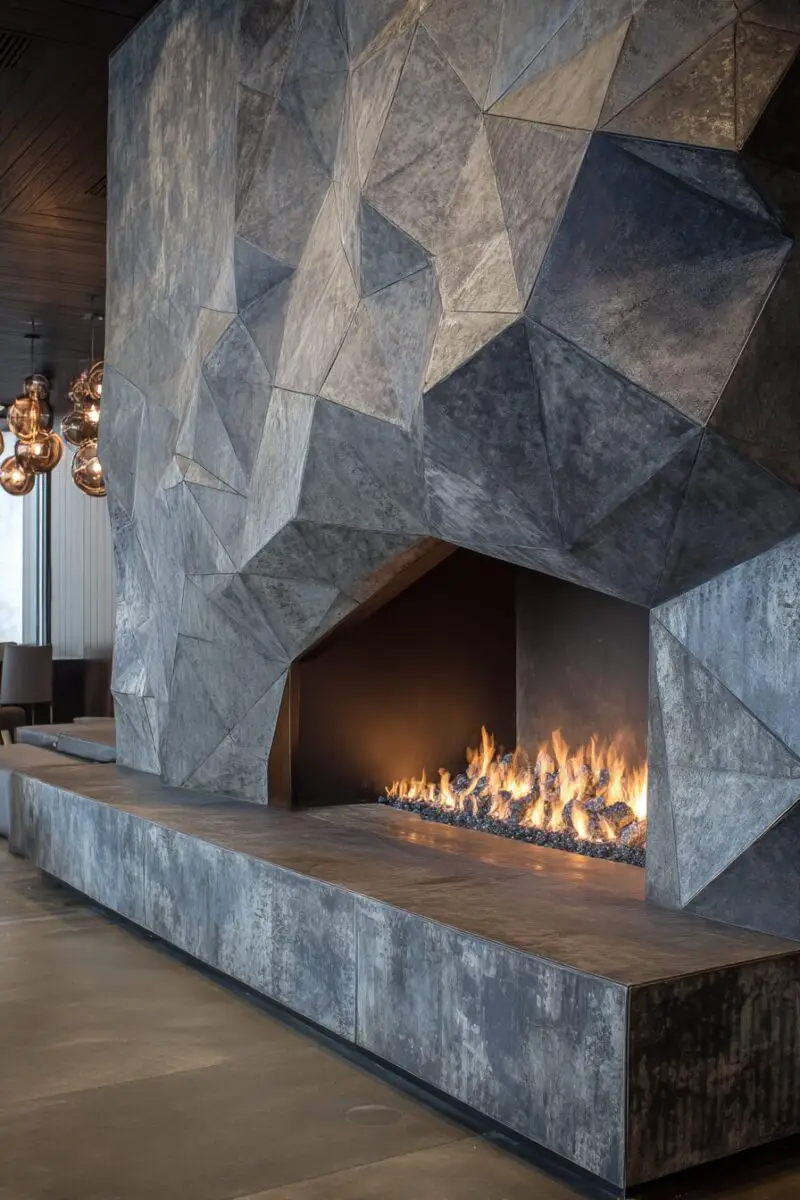
Picture a fireplace that transforms natural stone into a work of contemporary art through precise geometric patterns and clean, minimalist lines.
A geometric stone pattern fireplace brings together the organic beauty of natural materials with the structured precision of modern design principles.
This approach creates a striking focal point that works perfectly in contemporary homes while maintaining the timeless appeal of natural stone.
The success of geometric stone patterns lies in the careful selection and placement of stones to create repeating motifs or tessellated designs.
Mathematical precision guides the layout, with each stone cut to exact specifications to ensure perfect alignment and consistent spacing.
The patterns can range from simple rectangular grids to complex hexagonal tessellations or custom geometric shapes that reflect your personal design preferences.
Computer-aided design software allows for precise planning and visualization before any cutting or installation begins.
Stone cutting technology has advanced significantly, allowing for incredibly precise shapes and consistent dimensions.
Water jet cutting and diamond wire sawing can create complex geometric shapes with tolerances measured in millimeters.
This precision enables the creation of intricate patterns that would have been impossible with traditional cutting methods.
The investment in precise cutting pays dividends in the final appearance, as the tight joints and perfect alignment create a seamless, professional finish.
Color selection for geometric patterns should consider both contrast and harmony within the overall design scheme.
Monochromatic patterns using different shades of the same stone type create subtle sophistication and timeless appeal.
High-contrast patterns using stones of dramatically different colors create bold, contemporary statements that command attention.
The scale of the geometric pattern should be appropriate for the size of the fireplace and the room it occupies.
Large patterns work well in spacious rooms with high ceilings, while smaller, more intricate patterns are better suited to intimate spaces.
The installation process for geometric stone patterns requires exceptional skill and attention to detail.
Each stone must be placed with mathematical precision to maintain the integrity of the pattern.
Specialized adhesives and setting materials ensure permanent adhesion while allowing for minor adjustments during installation.
Laser levels and digital measuring tools help maintain accuracy throughout the installation process.
Even small deviations from the planned layout can disrupt the visual flow of the geometric pattern.
Grout lines in geometric patterns should be minimal and consistent to maintain the clean, modern aesthetic.
Contrasting grout colors can be used to emphasize the geometric pattern and create additional visual interest.
Neutral grout colors allow the stone pattern to take center stage without distraction.
The grout should be sealed properly to prevent staining and maintain the crisp appearance of the pattern lines.
Lighting design for geometric stone patterns should emphasize the precision and rhythm of the pattern.
Even, consistent lighting prevents shadows that could disrupt the visual flow of the geometric design.
Accent lighting can be used to create dramatic shadows that emphasize the three-dimensional aspects of the stone work.
The interplay of light and shadow becomes part of the overall design composition, changing throughout the day as natural light conditions vary.
These creative natural stone fireplace ideas demonstrate the incredible versatility and timeless beauty that stone can bring to your living space.
Remember that professional design and installation are key to achieving the best results with any of these complex stone fireplace projects
